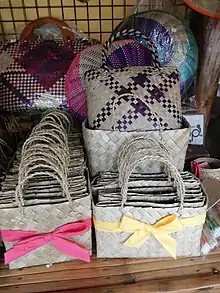



A bayong is a kind of bag originating in the Philippines and made by weaving dried leaves. The leaves used for making the bayong vary but the traditional bayong is made from buri leaves in the Visayas and pandan leaves in Luzon.[1][2] Abaca, bacbac, karagumoy, sabutan, romblon and tikog are among other organic materials used in making the bayong — all of which are derived from plants native to the Philippines.[2][3] Plastic strips are also used as synthetic substitute for leaves.[1]
The use of bayongs is common among Filipinos going to wet markets especially in rural areas or provinces. Recently the bayong is being promoted as an environmentally-friendly alternative to plastic shopping bags.[1]
It is not certain who exactly founded the bayong because it has long been a part of Filipino culture and tradition. The production and use of bayong is passed down from generation to generation, and it has become part of the daily life of the locals.
Other design
Some part of the Philippines such as Mindanao traditionally uses a plastic version or twine some times.[4]
References
- 1 2 3 "Filipino Icon: Bayong". FFE Magazine. 21 November 2013. Retrieved 29 January 2016.
- 1 2 Mendoza, Sonia (1 April 2012). "Use 'bayong,' cloth bag". Philippine Daily Inquirer. Retrieved 29 January 2016.
- ↑ Loterte, Marlon (19 September 2012). "Bayong evolves from traditional to modern design". Legazpi, Albay. Philippine Information Agency. Retrieved 29 January 2016.
- ↑ Admin, CDODev (2020-03-06). "Talakag's "Bayong" to be featured in New York". CDODev.Com. Retrieved 2021-08-19.
External links
![]() Media related to Bayong at Wikimedia Commons
Media related to Bayong at Wikimedia Commons